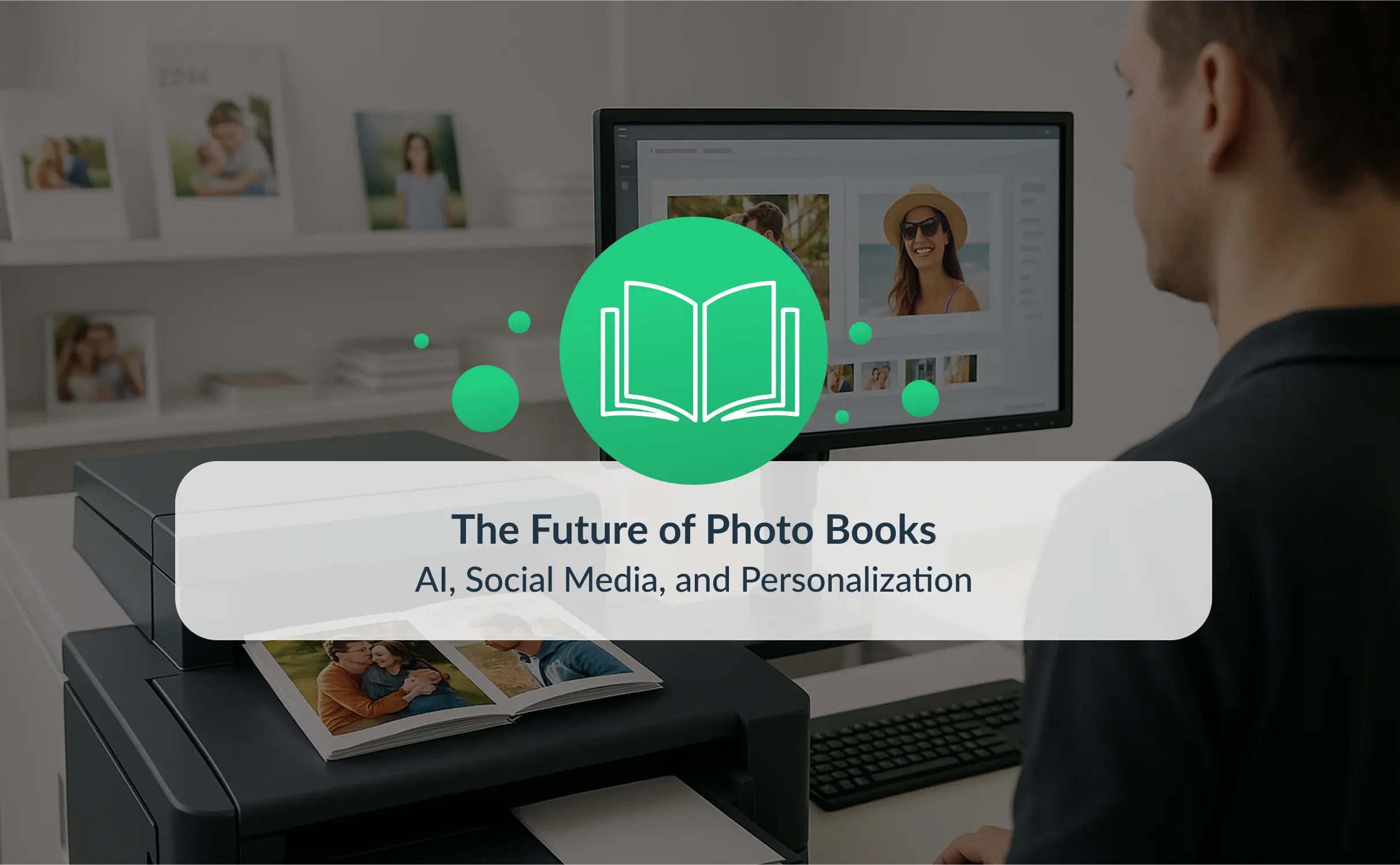There’s a growing appetite for ultra-personalized experiences in the photo book and album market—but delivering that at scale? That’s where friction arises. E-commerce teams often find themselves pulled in two directions: customers expect seamless, mobile-first design tools, while operations teams are focused on optimizing backend workflows and production speed.
The rise of digital technology and social media is dramatically reshaping the photobooks market. What’s evolving isn’t just the product format – it’s the entire ecosystem around how photo books are imagined, created, and sold. Below, we explore how photo book innovations are transforming this space, from AI-driven personalization to the impact of social media on memory-capturing culture.
Comparison between Traditional and Digital Photo Books
A decade ago, creating a photo album involved manually printing photos at a local lab, buying a physical book, and painstakingly arranging prints with captions by hand. That process, while nostalgic, was limiting in creativity, accessibility, and especially scalability. Fast forward to today’s photobooks market, and digital-first platforms have redefined what’s possible – including real-time customization, on-demand printing, and mobile-based creation.
In the modern photo book and album market, user expectations have shifted considerably. Digital photo books now:
- Allow dynamic personalization with drag-and-drop editors.
- Include features like auto-layout tools and theme-based templates.
- Support direct uploads from cloud storage and smartphones.
Many brands are now implementing live preview features that mimic the final printed product with remarkable accuracy. We’re seeing a shift where customers expect WYSIWYG (“what you see is what you get”) interfaces that reflect not just layout but even paper texture and cover finishes. This level of visual simulation improves buyer confidence and reduces order abandonment.
Furthermore, production workflows have evolved. Digital formats allow centralized control and more efficient handling, from online ordering systems to automated prepress checks, dramatically cutting down production time and errors. For e-commerce teams, that widens margins while boosting customer satisfaction. In short, the digital shift isn’t just an aesthetic upgrade – it’s a transformation of the entire business model behind the photo book and album market.
Integration with Social Media
If digital photo books unlocked convenience, social media injected emotion and immediacy. Today’s users are capturing moments across various platforms in real-time, and increasingly, they want to turn those snippets into tangible keepsakes. Personalized photo books are becoming an extension of online storytelling.
Key social platforms and cloud-based services now serve as creation hubs. Facebook, for example, archives entire albums over the years, providing a rich, organized content stream that can be easily pulled into design tools. This not only streamlines the creation process but empowers customers to preserve memories in the exact visual language they used online.
A growing number of players in the personalized photo products space are integrating one-click imports from social media and cloud storage – especially from Google Photos. We’ve found this feature significantly increases design session completion rates because it eliminates friction in the user journey. Customers no longer need to manually upload files, especially on mobile devices where storage is limited.
From a branding perspective, this also changes how businesses market photo books. Campaigns now invite users to “print your year from your favorite online albums” or “transform your event memories into a hardcover book” – making the product feel hyper-current and emotionally relevant. As social media continues to evolve with features like ephemeral content and reels, businesses have an opportunity to innovate how those formats can be translated into print.
This shift represents one of the most compelling photo book innovations in the last five years: the blending of transient digital moments with the permanence of print.

The Role of Artificial Intelligence in Photo Book Creation
One of the most impactful trends in photo books today is the use of artificial intelligence to streamline and personalize the creation process. For years, users have been overwhelmed by the task of selecting photos, arranging layouts, and finalizing designs. AI now offers a much more accessible entry point – even for those with no design experience.
Automation can now handle several major tasks:
- Photo curation: Selecting the highest-quality and most emotionally resonant images.
- Smart layout generation: Balancing image orientation, focal points, and spacing.
- Face recognition: Ensuring key people appear prominently throughout the album.
What this means for vendors in the photo book and album market is reduced drop-off rates and higher customer satisfaction. Users no longer hit creative fatigue midway through design—instead, they review and tweak a strong foundation generated by AI.
It’s becoming increasingly common to offer AI-assisted photo books as a fast-track option during onboarding. One innovation we’re seeing is offering customers a pre-assembled book preview seconds after photo upload – complete with themes, color palettes, and recommended cover photos. This “instant book” approach keeps momentum high and greatly improves conversion metrics. A notable solution in this area is Smart Creation, which streamlines the design process and enhances the customer experience. By integrating this tool, businesses can elevate their offerings and drive higher engagement and sales.
Businesses exploring photo book innovations should consider AI not just as a novelty, but as a core UX enhancer. Whether through smart cropping, sentiment analysis, or predictive layout preferences, the goal is the same: reduce friction while maximizing aesthetic and emotional value. For a deeper look at these technologies, check out AI: The Future of Personalized Printing.
Future Predictions for Photo Books
Looking ahead, trends in photo books suggest an even stronger focus on real-time relevance, seamless UX, and hyper-personalization. As print-on-demand technology advances, expect near-instant photo book shipping with shorter production cycles and local fulfillment options. This reflects a broader industry shift toward faster, smarter supply chains in personalized e-commerce.
Meanwhile, generative AI is likely to play an increased role – not just in layout, but also in content. Imagine books that include auto-generated captions, location tags, and even narrative text based on image analysis, all editable by the user. The personalization bar keeps rising.
The industry is moving toward cross-format storytelling – where a photo book isn’t just a standalone product, but part of a larger suite that includes video montages, calendars, or wall décor using the same core images. Offering these bundles has shown strong uptake among users who want consistency without extra effort. This multiplatform approach also unlocks higher cart values and stronger retention.
Voice-command layout tools, immersive mobile editing interfaces, and augmented reality previews are also on the horizon. These shifts align with broader Trends in Printing Technology, where customization and immediacy go hand-in-hand.
Still, the emotional core of photo books remains unchanged. People want to preserve what matters – and the tools we use just need to honor that instinct with more beauty and less friction.
Ready to Evolve Your Photo Book Strategy?
The photo book and album market is evolving fast – but the upside for businesses that adapt is massive. Want to see how you can future-proof your offering? Book a Printbox demo and get a firsthand look at what’s possible with next-gen tools. Or if you’d rather talk strategy, contact the Printbox team – we’re here to help your users bring more meaningful memories to life.
What are the latest trends in personalized photo books?
Modern photo books are embracing AI-driven personalization, seamless mobile creation, and social media integrations that allow users to easily turn their digital memories into printed keepsakes.
How is AI used in photo book creation?
AI helps automate photo selection, layout design, and even theme customization, allowing users to generate high-quality, emotionally resonant albums with minimal effort.
Can I create a photo book directly from my Facebook or Google Photos?
Yes, many platforms now offer one-click imports from Facebook, Google Photos, and other social media, streamlining the process of turning digital memories into physical photo books.
How do e-commerce brands benefit from modern photo book tools?
By integrating AI, mobile-first design tools, and backend automation, brands can improve user experience, speed up production, reduce errors, and increase customer satisfaction.
What’s the future of photo book personalization?
Expect even smarter tools like generative captions, AR previews, and voice-assisted design, all aimed at making photo books more intuitive, personal, and emotionally impactful.




